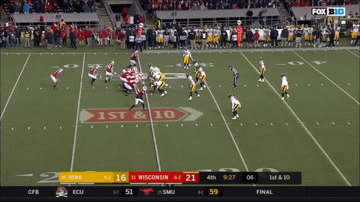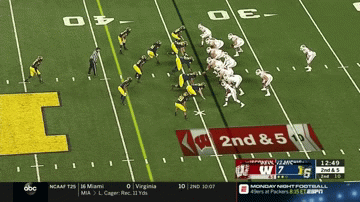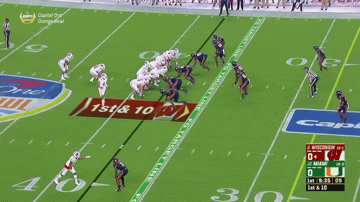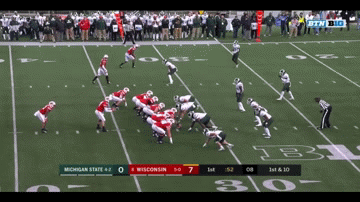Jonathan Taylor – Wisconsin – 5’11” 219 lbs. – 21 Years Old (1/19/99)
Taylor comes into the draft after a college career where he averaged 308 carries and 2,058 yards per season. He’s on the more physical side of running styles and has developed into a more complete back.
- Power running scheme at Wisconsin with a terrific O line. Taylor utilizes his strong line and is a patient running back. He will wait for his O line rather than simply running head first into battle where the play is designed.
- Lateral quickness as a whole is average. In short area lateral moves, he showed the ability to maintain, or get back up to speed quickly. However, in larger jump cuts, he slows more than other backs and gives defenders time to catch up.
- He utilizes a stiff arm with those short area lateral moves to break free or get the defender off balance.
- While Taylor doesn’t have the acceleration of other backs in this class, his initial burst is strong. It’s something I’d equate to a basketball player with a good first step.
- Taylor made big plays regularly for the Badgers, but his long speed is not top end. There are times on film where he fails to get the corner or outrun the last defender to make it a home run play. It’s not that he can’t accelerate or make big plays, but he lacks the 2nd gear to be a home run threat.
In the clip below, JT lets his blocks get set up, then, he cuts back into the opening. He gets a couple steps in before the first defender is on him and uses a nasty spin move to avoid the tackle. The acceleration kicks in and he gets downfield for 20 yards more. However, you can also see the lack of top end speed after the initial acceleration as it costs him a chance at more yardage.
- Taylor is a downhill runner. He does not shy away from contact. He has a knack for reaching the mark whether that be for a first down or touchdown.
- JT has exceptional balance and can take a hit while staying on his feet or stay upright and push (or be pushed by) a pile.
- Don’t let the bruiser mentality fool you, JT can get thin and run through small cracks in the line.
Small hesitation to let the cut back on the left open up and then squeezes through the line. Needs 5 yards and gets 10 by staying upright. He pushes/carries 3 guys for a few yards before his O linemen can come and help with a few more at the end.
- JT has developed as a runner over the course of his 3 seasons.
- Each season he developed into a more patient, smarter runner. His vision at the line and beyond has continued to improve becoming something that is now an asset rather than a liability.
- In his last season (as a junior), he finally was given some receiving work with 26 receptions for 252 yards.
- His receiving ability is not strong and will be a work in progress to become a three down back. He showed a little promise on quick breaking routes with his good “first step” action.
- Taylor did utilize the open space in the receiving work to get up to speed and averaged nearly 10 yards per reception.
- However, he is not a natural receiver. He does best when given a chance to turn around and body catch. He does not get to the correct spots on dump offs and swing routes at times. His ability to adjust to the ball is minimal, so, the QB has to put it on him.
- Unfortunately, while he has become a more intellectual runner, his physical gifts may have taken a tiny step back. There is a burst and top end speed he displayed in his freshman season that just isn’t there consistently in his junior year. We’ll have to wait for the combine, but one explanation, other than workload, would be that Taylor has bulked up 5-10 pounds since arriving in Madison.
There’s not much tape from his freshman season, but here is an example of the changes he has made. Maybe this is just the best delay of all time, but seems like JT wasn’t really paying attention. Once he gets the ball, you can see that the initial burst is impressive and he’s more like the track star we heard about coming from high school. However, you also see at the end of the run, he has blockers out in front of him. Then, rather than use them to set up a longer run, he simply runs straight into the first defender.
- One of the bigger concerns on Taylor is the workload that he had in college.
- While the workload concerns overall may be a bit overblown, there was a bit of an odd trend for his long runs during individual games.
- In reviewing his game logs against legitimate competition, Taylor’s big runs came primarily in the 1st half. Only 2 or 3 of those runs against real competition came in the 2nd half of those games. Additionally, he averaged 7.2 yards per carry (not my favorite stat) in the first quarter compared to 5 in the 2nd quarter.
Here’s JT in what he does best. This is a physical run that showcases his vision, short range lateral ability, acceleration, and toughness. He displays his short area lateral moves, then the stiff arm, plus the power and balance to drag a defender behind him.
There are other analysts and scouts that are more excited about Jonathan Taylor’s prospects. In my opinion, Taylor just lacks some of the upside that the other top RBs in this class offer. Before we get combine numbers and team assignments in the draft, Taylor is outside of my top 3 running backs for 2020.






